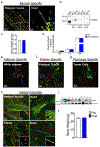Conditional MitoTimer reporter mice for assessment of mitochondrial structure, oxidative stress, and mitophagy
- PMID: 29274400
- PMCID: PMC6387589
- DOI: 10.1016/j.mito.2017.12.008
Conditional MitoTimer reporter mice for assessment of mitochondrial structure, oxidative stress, and mitophagy
Abstract
Assessment of structural and functional changes of mitochondria is vital for biomedical research as mitochondria are the power plants essential for biological processes and tissue/organ functions. Others and we have developed a novel reporter gene, pMitoTimer, which codes for a redox sensitive mitochondrial targeted protein that switches from green fluorescence protein (GFP) to red fluorescent protein (DsRed) when oxidized. It has been shown in transfected cells, transgenic C. elegans and Drosophila m., as well as somatically transfected adult skeletal muscle that this reporter gene allows quantifiable assessment of mitochondrial structure, oxidative stress, and lysosomal targeting of mitochondria-containing autophagosomes. Here, we generated CAG-CAT-MitoTimer transgenic mice using a transgene containing MitoTimer downstream of LoxP-flanked bacterial chloramphenicol acetyltransferase (CAT) gene with stop codon under the control of the cytomegalovirus (CMV) enhancer fused to the chicken β-actin promoter (CAG). When CAG-CAT-MitoTimer mice were crossbred with various tissue-specific (muscle, adipose tissue, kidney, and pancreatic tumor) or global Cre transgenic mice, the double transgenic offspring showed MitoTimer expression in tissue-specific or global manner. Lastly, we show that hindlimb ischemia-reperfusion caused early, transient increases of mitochondrial oxidative stress, mitochondrial fragmentation and lysosomal targeting of autophagosomes containing mitochondria as well as a later reduction of mitochondrial content in skeletal muscle along with mitochondrial oxidative stress in sciatic nerve. Thus, we have generated conditional MitoTimer mice and provided proof of principle evidence of their utility to simultaneously assess mitochondrial structure, oxidative stress, and mitophagy in vivo in a tissue-specific, controllable fashion.
Copyright © 2017 The Authors. Published by Elsevier B.V. All rights reserved.
Figures



References
-
- Bruning JC, Michael MD, Winnay JN, Hayashi T, Accili D, Goodyear LJ, Kahn CR, 1998. A muscle-specific insulin receptor knockout exhibits features of the metabolic syndrome of NIDDM without altering glucose tolerance. Mol. Cell 2, 559–569. - PubMed
Publication types
MeSH terms
Substances
Grants and funding
LinkOut - more resources
Full Text Sources
Other Literature Sources
Molecular Biology Databases
Miscellaneous

